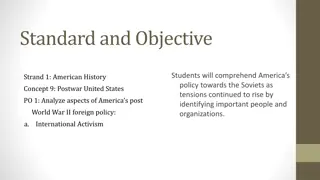America's Role on the Home Front during World War I
During World War I, America witnessed significant changes on the home front as the government took on new powers to regulate industry, agriculture, and public opinion. Women and minorities played crucial roles, voluntary rationing was embraced, and opposition by conscientious objectors was met with challenges. The mobilization for war saw a transformation in the nation's economy and the building of a larger army through the Selective Service Act. President Wilson led efforts to construct a war economy, shifting production to support the war effort. The impact of World War I on ordinary people was profound, with millions affected by the conflict.
Download Presentation

Please find below an Image/Link to download the presentation.
The content on the website is provided AS IS for your information and personal use only. It may not be sold, licensed, or shared on other websites without obtaining consent from the author. Download presentation by click this link. If you encounter any issues during the download, it is possible that the publisher has removed the file from their server.
E N D
Presentation Transcript
World War I The Home Front
US History Content Standards US. 26 Analyze the political, economic, and social ramifications of World War I on the home front, including: Role played by women and minorities Voluntary rationing Committee on Public Information Opposition by conscientious objectors Schenck v. United States decision
America Mobilizes for War Prior to World War I, the federal government played a small role in the daily lives of most Americans During the war, the government assumed new powers, regulating industry and agricultural production, shaping public opinion, and establishing the draft
America Mobilizes for War The greatest impact any war has is on the lives of ordinary people People fight, sacrifice, and die in war while others work to produce food and weapons War is the result of conflicts between nations, but it affects the lives of millions of individuals
Building an Army When the US entered World War I, they had a relatively small army To build up the army, Wilson called on volunteers for service and asked Congress to pass the Selective Service Act (Authorized the draft of young men for military service in Europe)
Building an Army On the first day of its enactment, 9.6 million Americans registered for the draft In July, the government held a lottery to decide the order in which the first draftees would be called into service Over the course of the war, more than 24 million Americans registered, 2.8 actually drafted Including volunteers, 4.8 million men served in the US armed forces during World War I
Constructing a War Economy President Wilson worked to shift the economy from peacetime to wartime production The Council of National Defense, formed in August 1916, established an array of new federal agencies to oversee different phases of the war effort
Constructing a War Economy Individual agencies regulated food production, coal and petroleum distribution, and railway use Problems and administrative overlap eventually led to the creation of the War Industries Board (WIB) which regulated all industries engaged in the war effort The agency determined what products would be made, where products went, and how much they would cost
Constructing a War Economy Future President Herbert Hoover headed the Food Administration Set prices high for wheat and other foodstuffs to encourage farmers to increase production Asked Americans to conserve food so that more food could be shipped to soldiers overseas
Shaping Public Opinion For these efforts to work, the American people had to support the war effort The Committee on Public Information (CPI) had the job of educating the public about the causes and nature of the war Wilson appointed George Creel as director of the CPI to sell America on the idea of the war
Opposition and Its Consequences Not all Americans supported the war effort Two ethnic groups, German Americans and Irish Americans, opposed the Allies Some Americans treated German Americans with prejudice or intolerance while others were pacifists who opposed war for any reason
Resistance to the Draft The draft created a lot of controversy in America Some Americans believed it was illegal intrusion of the federal government into their private lives Some men refused to cooperate while others tried to avoid the draft As many as 12 percent of men who received draft notices never responded to them
Resistance to the Draft Another group resisted the draft by becoming conscientious objectors (people whose moral or religious beliefs forbid them to fight in wars) Some conscientious objectors were treated badly by their local draft boards and humiliated in training camps
Women Work for Peace Many American women were opposed to the war Leading American feminists like Jane Addams formed the Women s Peace Party Jeannette Rankin, the first woman to serve in the U.S. House of Representatives voted against the war declaration
Cracking Down on Dissent The work of the CPI created a mood in America where open debate was not welcome and many felt the CPI stifled free expression June 1917: Congress passed the Espionage Act (allowed postal authorities to ban treasonable or seditious newspapers, magazines, or printed materials from the mail)
Cracking Down on Dissent The Act enacted severe penalties for anyone engaged in disloyal or treasonable activities Anyone found obstructing army recruiters, aiding the enemy, or generally interfering with the war effort could be punished by a $10,000 fine or 20 years in prison
Cracking Down on Dissent 1918: Congress passed the Sedition Act which made it unlawful to speak against the US form of government, the Constitution, or the military The government employed the Sedition Act to prosecute socialists, political radicals, and pacifists
Cracking Down on Dissent Eugene V. Debs, the leader of the Socialist Party, was sentenced to 10 years under the act for giving a mildly antiwar speech at a socialist convention in Canton, Ohio The Supreme Court ruled in Scheneck v. United States (1919) that the Sedition Act was constitutional because the need for public order is so important that First Amendment protections do not apply
Prejudice Against German Americans During the war, some German Americans were treated harshly due in part to the work of the CPI and other groups Americans stopped teaching German in school and stopped playing music by German conductors German Americans were pressured to stop speaking German, reading German language newspapers, and pressured to prove their American patriotism
The Changing American Society The war brought about many social changes, including opening up opportunities for women, African Americans, and Mexican Americans Before the war, many women concentrated on winning the right to vote, and although some women felt the war would distract from the movement, it actually opened up more opportunities for them As men entered the military, many women moved into the workforce for the first time
The Changing American Society Many women began working in jobs that were previously only open to men such as in munitions factories, railroads, telegraph operators, etc. Many women joined the Red Cross or went to Europe as doctors, nurses, ambulance drivers, and clerks By their efforts and sacrifices, women convinced Wilson to support suffrage and in 1919 the Nineteenth Amendment was passed giving women the right to vote
African Americans Move North The war presented new opportunities for African Americans Most African American leaders supported the war effort, seeing it as an opportunity for them to show all Americans African American loyalty and patriotism Thousands enlisted or were drafted into the army and shipped to France to fight
African Americans Move North African Americans fought in segregated units commanded by white officers 367,000 African Americans served in the military and hundreds died for their country
African Americans Move North During the war, African Americans moved from the rural South to the industrial North in what was called the Great Migration African Americans left the South hoping to escape violent racism, better jobs, and better futures for their children Between 1910 and 1920, more than 1.2 million African Americans moved to the North























